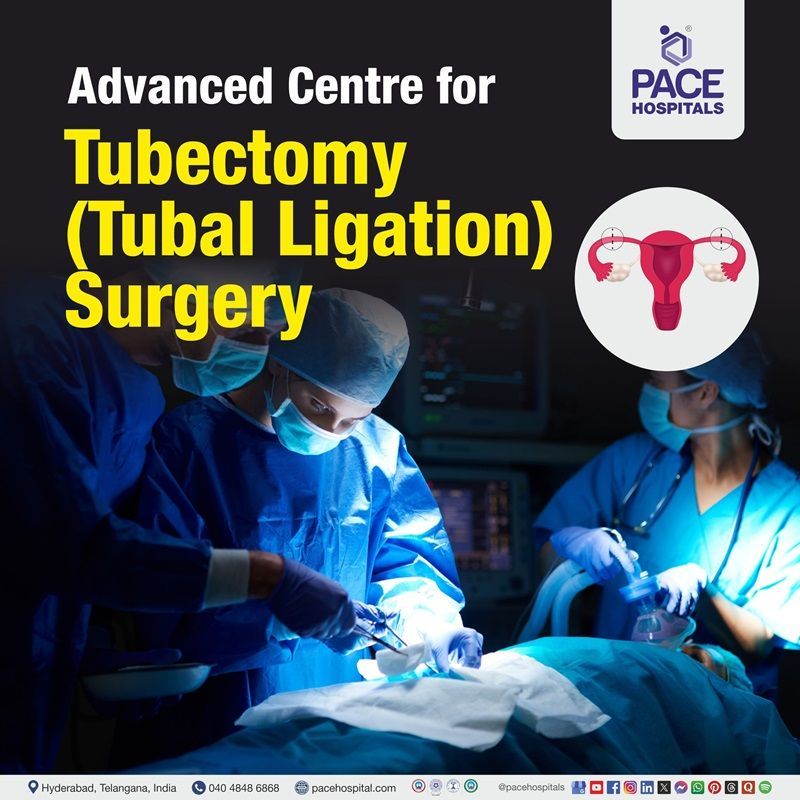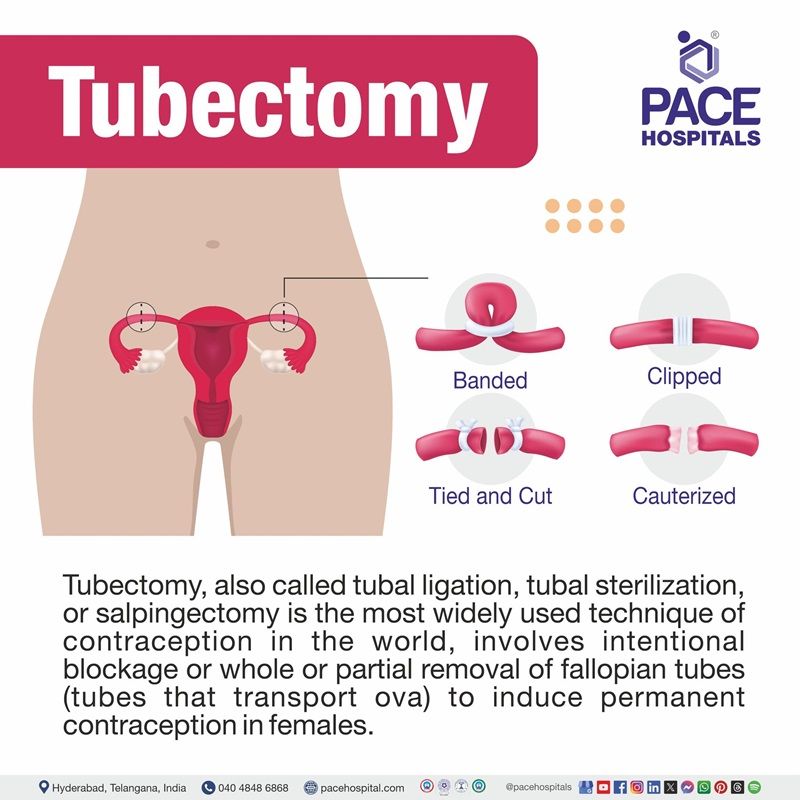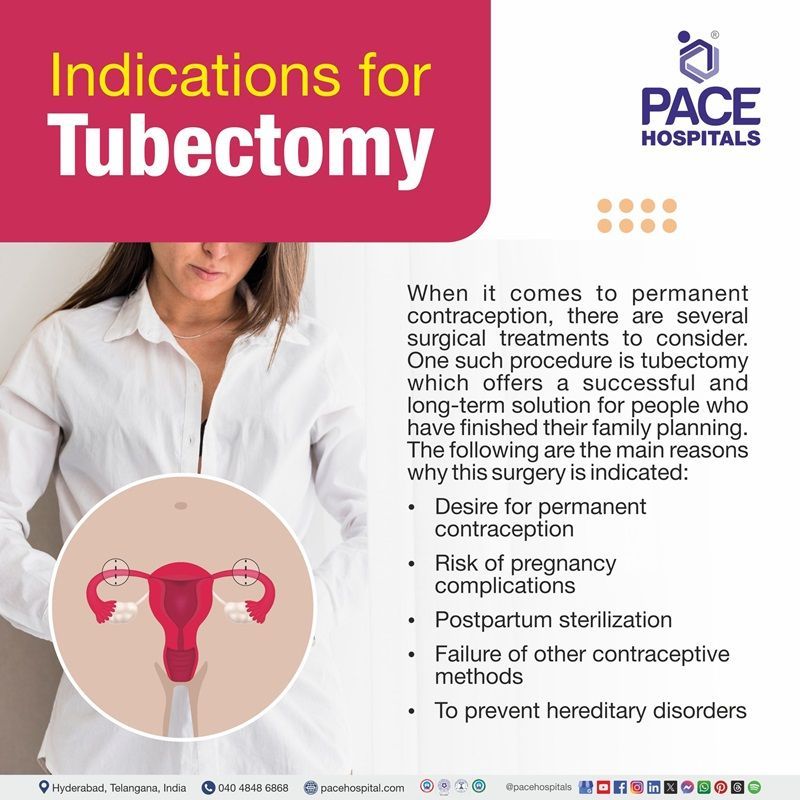Tubectomy (Tubal Ligation) in Hyderabad, India - Procedure Success Rate
PACE Hospitals is renowned as the Best Hospital for Tubectomy in Hyderabad, India, offering safe, effective, and minimally invasive procedures for permanent female sterilization. Our team of highly skilled gynecologists and laparoscopic surgeons ensures precision and patient comfort, using advanced techniques like laparoscopic tubectomy (tubal ligation) to minimize recovery time and complications. With state-of-the-art operation theaters, a 3D HD laparoscopic system, personalized care, and a commitment to women’s health, PACE Hospitals provides a seamless surgical experience ensuring long-term reproductive health with the highest standards of safety and excellence.
Request an appointment for
Tubectomy Operation
Tubectomy Surgery Appointment
Why choose PACE Hospitals for Tubectomy Surgery in Hyderabad?

Advanced State-of-the-Art Surgical Techniques
Team of the Best Gynecologists and Laparoscopic Surgeons in Hyderabad
Precision Treatment with 99.9% success rate
All insurance accepted for Cashless Treatment
What is Tubectomy?
Tubectomy definition
Tubectomy, also called tubal ligation, tubal sterilization, or salpingectomy, is the most widely used technique of contraception in the world, involves intentional blockage or whole or partial removal of fallopian tubes (tubes that transport ova) to induce permanent contraception in females. This technique is recommended when the patient wishes to use permanent contraception; the only absolute contraindication is a lack of informed consent from the patient.
Tubectomy surgery is normally performed by an obstetrician-gynecologist (OB-GYN), a doctor who specializes in women's reproductive health.

Tubectomy meaning
Tubectomy is a compound word derived from the Latin words "tuba," meaning tube, and "ectomy," meaning surgical removal. This etymological arrangement emphasizes the procedure's focus on the surgical removal or modification of the fallopian tubes.
Tubal ligation meaning
The term "tubal ligation" is the combination of the words "tubal" and "ligation" in which “tubal” refers to the fallopian tubes that connect the ovaries to the uterus and “ligation” means to tie off.
Types of Tubectomy (Tubal Ligation)
Tubectomy is often chosen by women who are certain that they do not wish to have any more children. There are various types of tubal ligations, each with its own set of benefits, risks, and considerations. Understanding the various ways is critical for healthcare practitioners and patients to make an informed decision. The most common tubectomy types include:
- Laparoscopic tubectomy
- Laparotomy
- Mini laparotomy tubectomy
- Hysteroscopy
Laparoscopic tubectomy
Laparoscopy is a surgical procedure that examines the organs of the abdomen. It can also check a woman's pelvic organs.
Laparoscopic tubal ligation is a surgical sterilization treatment that involves clamping and blocking a woman's fallopian tubes or severing and sealing them. Both methods prevent eggs from becoming fertilized. Tubal ligation is a permanent form of sterilization.
Tubal ligation can be performed during the peripartum period or at any time after pregnancy (known as interval sterilization). Approximately half of the female sterilizations are interval sterilizations, with the other half performed after cesarean delivery or immediately after birth. Most interval sterilizations are done laparoscopically.
Laparotomy
Laparotomy, or celiotomy, is performed by making a wide incision in the abdomen to look into the peritoneal cavity. Tubectomy by laparotomy is a more comprehensive approach. It involves making a bigger incision in the abdomen of around 6-12 inches, following which the fallopian tube is closed.
Mini laparotomy tubectomy
Mini laparotomy is also called a mini lap. Mini laparotomy is a surgical procedure that involves entering the lower abdominal cavity through a small transverse suprapubic incision to perform tubal ligation. For the majority of women seeking sterilization, mini laparotomy is an excellent option.
Hysteroscopy
Hysteroscopic tubal sterilization is a minimally invasive technique alternative to laparoscopic tubal ligation for women seeking permanent contraception. Permanent micro-implants are placed into both fallopian tubes without surgery.
Tubectomy procedures vary depending on the patient's health, the surgeon's experience, and the intended outcome. These techniques differ in terms of their strategy, invasiveness, and recovery time. The following are the most regularly utilized tubectomy procedures.
Laparoscopic approaches
Laparoscopy is the principal method for performing interval tubal sterilization treatments. It is not necessary to apply the same approach for both tubes. However, each fallopian tube must be totally or partially removed, or completely obstructed.
Bilateral salpingectomy
Laparoscopic bilateral salpingectomy is becoming the recommended method of tubal sterilization since it is associated with reduced risks of ovarian cancer and reduced surgical risk. Though long-term data are not yet available, bilateral salpingectomy is theoretically the most effective sterilization method. Furthermore, salpingectomy is frequently preferred when the tube is substantially aberrant.
Tubal occlusion procedures
Laparoscopic tubal occlusions are extremely similar to laparoscopic salpingectomy. An occlusive treatment focuses on the mid-isthmic tubal region rather than the tube itself. This narrowest section makes it the easiest and most efficient to occlude. Occlusion at the proximal isthmus, within 2 cm of the uterine cornua, poses a theoretical risk of fistula formation, but occlusion at more distal tubal segments is associated with higher contraceptive failure rates.
Open Approaches
Tubal sterilization can also be performed using an open method. If the patient has a cesarean delivery, tubal sterilization occurs immediately after the hysterotomy is closed and before the abdominal incision is closed. Following a vaginal delivery, tubal sterilization is usually performed via a small laparotomy under regional anesthesia. In addition, a small laparotomy may be performed in patients who are at high risk for laparoscopy or in places with limited laparoscopic facilities.
Parkland technique
A Babcock clamp is used to raise the mid-isthmic part of the fallopian tube, creating a window in the avascular plane of the mesosalpinx beneath the tube. Two pieces of dissolvable suture (e.g., 0-chromic or plain gut) are threaded through this window and utilized to bind the proximal and distal ends of a 2- to 3-cm segment of the isthmic fallopian tube. The ligated tube portion is then removed sharply between the sutures. To ensure that the right anatomic component is resected, the tubal lumen should be visible within the tube's cut end.
Pomeroy method
The mid-isthmic part of the tube is elevated, allowing the proximal and distal ends to meet. A single strand of a fast absorbable suture (such as a 1-0 or 0 plain gut suture) is wrapped around both the proximal and distal sections of the tube, forming a loop or "knuckle" of the fallopian tube above the suture. If desired, a second suture can be inserted under the first. The tube portion above the suture ligation is then sharply removed. To ensure that the right anatomic component is resected, the tubal lumen should be visible within the tube's cut end. As the suture is absorbed, the proximal and distal ends separate from one another.
Hysteroscopic approaches
Previously, hysteroscopic tubal sterilization devices were available. The most common hysteroscopic sterilization device allows the practitioner to insert a tiny metallic coil into each fallopian tube. These coils subsequently triggered a local inflammatory response, resulting in scar tissue that clogged the tubes over the next few months.
As a result, this treatment was not immediately effective and required a follow-up hysterosalpingogram three months later to achieve tubal closure. There is concern that these coils may increase the risk of chronic pelvic pain caused by perforation, coil migration, or nickel allergy. However, the evidence is equivocal, and the true association between coil placement and chronic pelvic pain remains unclear. As a result, women who have already had this treatment and have not had any bad effects may keep the device in place.

Indications for Tubectomy (Tubal Ligation)
When it comes to permanent contraception, there are several surgical options to consider. One such procedure is tubectomy which offers a successful and long-term solution for people who have finished their family planning. The following are the main reasons why this surgery is indicated:
- Desire for permanent contraception: The main indication for tubectomy is the patient's informed desire for permanent contraception. This decision should be taken after carefully considering all available contraceptive options, including their efficacy and risks. Tubectomy is meant to eliminate future fertility, making it a good choice for women who do not wish to have any more children in the future.
- Risk of pregnancy complications: In cases where pregnancy poses a considerable risk to a woman's health due to pre-existing medical issues, a tubectomy may be indicated to prevent future pregnancies.
- Postpartum sterilization: Tubectomy can be performed in the early postpartum period, especially following a cesarean delivery. This method is advantageous because it allows women who are currently undergoing surgery to undergo sterilization without having to undergo another treatment later. Because of its simplicity and effectiveness, it is widely accepted and practiced.
- Failure of other contraceptive methods: Women who have failed to use other forms of contraception may consider tubectomy as a more reliable option. This includes situations where hormonal techniques or barrier methods were not effective, resulting in unwanted pregnancies.
- To prevent hereditary disorders: Women may choose to undergo tubectomy to prevent hereditary diseases, if anyone in a couple either the male or female has a genetic condition that they do not want to pass down to a child.
Tubectomy contraindications
When considering the contraindications of tubectomy (tubal sterilization), it is critical to consider all the reasons that may impact a patient's decision to undertake this permanent form of contraception. Tubectomy is a major surgery, and understanding its limitations and contraindications is crucial for patient safety and satisfaction.
Some common tubal ligation contraindications may include:
- Lack of informed consent: The absolute contraindication of tubal ligation is a lack of informed consent from the patient. Before continuing with sterilization, the patient must completely understand the procedure, its permanent nature, and other contraceptive choices.
- Severe obesity: Obesity may complicate tubectomy surgery. Obese women are more prone to the risks of general anesthesia than women with a normal BMI.
- Significant cardiopulmonary or renal disease: These conditions increase the risk of anesthesia. The laparoscopic method is also not recommended for patients with significant cardiopulmonary illness or dysfunction. The pneumoperitoneum can compress the vena cava and azygous system (network of veins), reducing cardiac return and leading to cardiac decompensation.
- Age and parity : Young age and low parity (few or no children) may not be considered absolute contraindications to sterilization, although caution and thorough counseling are recommended. In particular, the possibility of regret must be thoroughly emphasized to patients.
- Psychosocial factors: Patients who express uncertainty about their decision to have sterilization should be properly counselled on alternative contraceptive methods. If a patient exhibits evidence of coercion (against the patient's will) or pressure to have the treatment, it should be postponed until they can make an autonomous decision.
- Previous abdominal surgeries: A history of multiple abdominal or pelvic procedures may raise the likelihood of adhesions, complicating surgical access.
- Active infection: Any active pelvic infection should be managed before undergoing a tubal ligation to avoid the risk of postoperative complications such as infection or abscess formation.

Advantages of Tubectomy (Tubal Ligation)
Tubal ligation is considered permanent birth control and is approximately 99% effective in preventing pregnancy. If a person is certain that she does not want to become pregnant again, having the tubes tied is a safe and simple method of contraception.
Other advantages of tubal ligation include:
- High effectiveness: Tubectomy is a highly effective form of contraception, with a failure rate of less than 1% in the first year. This level of efficiency is comparable to that of long-acting reversible contraceptives, making it a reliable alternative for women desiring permanent sterilization.
- Hormone free contraception: Unlike many contraceptive methods that rely on hormonal treatments, tubectomy offers a hormone-free option for women who may have medical contraindications to hormonal contraception or choose to avoid them because of negative effects. This makes it especially appealing for people who have had negative reactions to hormonal treatments.
- Reduced ovarian cancer risk: Tubectomy, especially when performed as a full salpingectomy (removal of the fallopian tubes), has been shown in studies to greatly lower the risk of ovarian cancer. Studies indicate that this approach can reduce the risk by 42% to 78%, which is especially important for women with genetic predispositions such as BRCA mutations. This preventive feature is increasingly recognized as an important advantage of the procedure.
- Reduced pelvic inflammatory disease (PID) risk: Tubectomy, by occluding or removing the fallopian tubes, minimizes the possibility of sexually transmitted infections climbing into the pelvic cavity, thereby reducing the risk of developing PID and its accompanying complications.
- Immediate effectiveness: Tubectomy provides instant contraception, reducing the need for long-term contraception methods like tablets or devices. This immediate effectiveness is beneficial for women who want to avoid unplanned pregnancies without delay.
- Improved quality of life:
Some studies suggest that women who undergo tubectomy may report increases in quality of life in terms of sexual health and autonomy over reproductive decisions, particularly those at high risk for specific malignancies.
Tubectomy procedure steps
Tubectomy is a procedure that permanently prevents conception by closing or sealing the fallopian tubes. To make an informed decision, women must first comprehend the procedure's steps. The following are the typical steps taken during a tubectomy.
Preoperative preparation:
The patient's medical history is reviewed, contraindications are evaluated, and Informed consent is obtained. The patient is informed about the procedure and its complications.
An intravenous (IV) line is placed for anesthesia and fluids.
Anesthesia administration:
The procedure is typically performed under general anesthesia; however, local or spinal anesthesia may be utilized based on the patient's needs and the surgeon's decision.
Incision
The procedure is typically performed under general anesthesia; however, local or spinal anesthesia may be utilized based on the patient's needs and the surgeon's decision.
Insufflation
Carbon dioxide gas is pumped into the abdominal cavity to inflate it, increasing visibility and room for surgical manipulation.
Laparoscopic insertion
A laparoscope, a tiny tube containing a camera, is placed through one of the incisions. This allows the surgeon to see the Fallopian tubes and the surrounding structures on a monitor.
Identification of fallopian tubes
Before sterilization, the surgeon locates both fallopian tubes and examines them for any anomalies or adhesions that may exist.
Tubal occlusion
Several methods can be used to create tubal occlusion:
- Clipping: Titanium or spring-loaded clips are used to obstruct tubes.
- Cauterization: This involves using electrocoagulation to close the tubes.
- Banding: Placing silicone bands around tube portions.
Closure of incisions:
After successful tube occlusion or removal, the laparoscope and instruments are removed, and the incisions are closed with sutures or adhesive strips.
Postoperative care:
The patient is monitored in recovery for any complications related to anesthesia or surgery.
There are instructions for postoperative care, activity limits, and symptoms of probable problems that require medical treatment.
Follow-up:
A follow-up consultation is scheduled to assess recovery and address any post-surgical problems.
Tubectomy complications
Tubal ligation is a safe procedure however all operations involve some risk. Serious challenges affect less than one out of every 1,000 women. Patients are required to sign a consent form outlining the risks and advantages of the operation, which they should review with their surgeon. Possible tubal ligation complications include:
- Bleeding from an incision or inside the abdomen: Light vaginal bleeding or spotting may occur but usually resolves within a few days.
- Infection : The incision areas are susceptible to infection, which may show up as pus, edema, or redness.
- Damage to other organs inside the abdomen: The tubectomy procedure may cause injury to adjacent organs, like the ureters or colon
- Side effects due to anesthesia: According to one study, individuals who receive local anesthesia report more back and leg discomfort, whereas those who receive general anesthesia report more pain in the upper limb and chest muscles. Other potential effects include anorexia, nausea, vomiting, headaches, and aches and pains.
- Incomplete closure of fallopian tubes that results in pregnancy: Although it is uncommon, tubal ligation can go wrong. It is possible to become pregnant if the tubes are not fully closed. Even though tubal ligation is a safe and effective form of birth control, about 1 out of 200 women may still become pregnant after the procedure. Having the surgery just after the period starts may avoid the chance that an already fertilized egg will reach the uterus after surgery.
Post tubectomy complications
The conditions that may increase the risk for other health-related problems may include:
- Diabetes
- Previous abdominal surgery
- Pelvic inflammatory disease
- Lung disease
- Obesity
Patients may have other tubectomy side effects, depending on their specific health condition. It is recommended to discuss any concerns with the surgeon before the procedure.
Complications of laparoscopic tubectomy
Laparoscopic tubal ligation complications include the need for anesthesia and the cost of laparoscopic equipment. The procedure is normally performed under general anesthesia, which has its own set of risks. Any surgery that enters the peritoneal cavity involves inherent risks, including the rare risks of intestinal injury, hemorrhage, transfusion, and, in some sterilization techniques, thermal injury. Every sterilization process has the risk of failure and regret.
Long-term side effects of tubectomy
Tubal sterilization may pose the following long-term risks and complications:
- Pregnancy: Though this technique is more than 99% effective, there is a very small risk of the tubes becoming unblocked, implying that a pregnancy could occur.
- Ectopic pregnancy :
Ectopic pregnancy after tubectomy may occur when a pregnancy develops outside the womb (typically in the fallopian tubes) rather than within the uterus (womb).
Questions that the patients can ask the healthcare team about the tubectomy procedure?
- What is a tubectomy, and how does it work?
- What are the different techniques available for tubectomy?
- How long does the procedure take, and what is the expected recovery time?
- What are the potential risks and complications associated with tubectomy?
- How does tubectomy compare to other contraceptive methods in terms of safety and effectiveness?
- What should I expect in terms of menstrual cycle changes after the procedure?
- Is there any possibility of pregnancy after a tubectomy?
- What are my options if I change my mind about having children in the future?
- What pre-operative assessments will I need?
- What kind of anesthesia will be used during the procedure?
- What post-operative care will I need?
- When can I resume normal activities after the surgery?
Difference between vasectomy and tubectomy
(tubal ligation)
vasectomy vs tubectomy
Vasectomy and tubectomy are the two popular and permanent contraception operations for men and women, respectively. Both aim to provide long-term birth control, but they differ in their process, target area, reversibility, and surgical complexity. The table below summarizes the difference between tubectomy and vasectomy.
| Aspect | Vasectomy | Tubectomy |
|---|---|---|
| Procedure | Involves cutting and sealing the vas deferens (male reproductive duct). | Involves cutting and sealing the fallopian tubes (female reproductive ducts). |
| Target area | Male reproductive system (vas deferens). | Female reproductive system (fallopian tubes). |
| Sterility effect | Results in male sterility, preventing sperm from entering the semen. | Results in female sterility, preventing eggs from reaching the uterus. |
| Reversibility | Generally considered reversible through vasovasostomy, though success rates vary. | Generally considered irreversible, though some methods may be reversible with surgery (success is lower). |
| Surgical complexity | Typically, a simpler, minimally invasive outpatient procedure. | More complex surgery, usually requiring general anesthesia, and may be done via laparoscopy or laparotomy. |
| Post-procedure recovery | Short recovery time (usually 1–2 days), minimal discomfort. | Longer recovery time (1–2 weeks), with potential for more discomfort |
Frequently asked questions (FAQs) on Tubectomy (Tubal Ligation) Surgery
Why is tubectomy considered a contraceptive method?
A tubectomy, commonly known as tubal sterilization or having the tubes tied, is considered a contraceptive method as it prevents pregnancy by closing the fallopian tubes. During a tubectomy, a surgeon cuts, ties together, or clips the fallopian tubes to prevent sperm from reaching the egg. This inhibits the egg from passing from the ovaries to the uterus.
What is vasectomy and tubectomy?
Vasectomy and tubectomy are two surgical procedures that sterilize males and females, respectively. The male sterilization operation involves cutting or restricting the vas deferens, the tubes that transfer sperm from the testicles to the urethra.
Female sterilization surgery involves cutting or restricting the fallopian tubes, which transport eggs from the ovaries to the uterus.
Does tubectomy stop periods?
No, tubectomy does not stop periods. Tubal sterilization prevents the passage of sperm through the fallopian tube. The ovaries continue to release eggs, which are then broken down and safely absorbed by the body. The ovaries are unaffected by sterilization. They continue to release the same hormones, and periods after tubectomy will proceed as usual.
Will periods become normal after tubectomy?
Yes. After the operation, women will continue to have periods (menstruation) and can have sexual intercourse. In fact, women may feel more at ease because they are not concerned about an unplanned pregnancy.
Can a tubectomy be reversed?
Yes. Tubal reversal may be appropriate for women who have had only minor portions of their fallopian tubes removed or if the tubes have been closed with rings or clips.
Some surgeons suggest the best candidates for tubal reversal are women under 40 who had their tubes shut soon after childbirth, a technique known as postpartum tubal ligation.
Where does the egg go after tubectomy (tubal ligation)?
After tubal ligation, the body absorbs the egg. Even if an ovum meets a sperm, fertilization may occur. Tubal sterilization prevents the passage of sperm through the fallopian tube. The ovaries continue to release eggs, which are then broken down and safely absorbed by the body. The ovaries are unaffected by sterilization.
Where is the block made in tubectomy (tubal ligation)?
During a tubectomy procedure, also known as tubal sterilization, the fallopian tubes that transport the oocyte are blocked to prevent eggs from reaching the uterus.
When to undergo laparoscopic tubectomy?
Laparoscopic tubectomy, also known as tubal ligation, is a permanent sterilization operation that can be performed at any time when a woman is not pregnant or during the postpartum period.
How much time would take for a tubectomy (tubal ligation) operation?
The actual surgery lasts for 30 minutes roughly. The surgeon will make one or more small incisions near the abdominal button. Sometimes the surgeon will make a minor incision in the lower abdomen as well.
Can I play sports after the tubectomy (tubal ligation) operation?
Following a tubectomy procedure, engaging in moderate physical activities have several health benefits, whereas excessive sedentary behavior, especial ly in regular exercisers, is harmful. Many doctors limit activity by following pelvic floor procedures, often for an indeterminate amount of time. The appropriate balance of exercise to support and maintain pelvic floor function in healthy people and those undergoing surgical procedures for pelvic floor diseases has yet to be determined.
Can a CT scan detect tubectomy (tubal ligation)?
Yes. A CT scan may identify tubal ligation, although it is not the ideal imaging tool to evaluate tubal abnormalities.
Is tubectomy painful?
Tubal ligation is performed as an outpatient procedure. It is safe and requires only a little recovery time. The operation may cause moderate pain, which can be managed with non-prescription or prescription pain medicines.
Can a tubal ligation be reversed naturally?
No, a tubal ligation cannot be reversed spontaneously. A tubal ligation is a permanent method of pregnancy control that includes cutting and tying the fallopian tubes. Reversing a tubal ligation involves extensive surgery to reattach the fallopian tubes, but the procedure is not always successful. However, general pregnancy success rates range between 40% and 85%.
Does tubal ligation cause weight gain?
No, tubal ligation, does not result in weight gain. Tubal ligation is a permanent birth control operation that does not influence the hormones or appetite.
What is Pomeroy tubectomy (tubal ligation)?
A Pomeroy tubectomy (tubal ligation) is a surgical technique used to prevent conception in women by closing the fallopian tubes. This is a partial salpingectomy. The pomeroy tubal ligation is a popular procedure for surgical female sterilization. The laparoscopic approach of Pomeroy tubal ligation employing endoloop sutures is often compared to the traditional technique of Pomeroy tubal ligation via Mini laparotomy.
What is the success rate of the tubectomy (tubal ligation) procedure?
Tubal ligation has been recognized as highly effective, with fewer than one in every 100 women becoming pregnant during the first year after surgery, indicating that tubectomy, also known as tubal ligation, is a permanent birth control technique with a success rate of more than 99%.
Can I get pregnant after tubectomy (tubal ligation)?
Yes, it is possible to become pregnant after a tubal ligation, although the chances are very low. Research states that even though tubal ligation is a safe and efficient method of pregnancy control, around one out of every 200 women may become pregnant following the procedure.
How to get an appointment for tubectomy (tubal ligation) surgery?
People in Hyderabad searching for 'Tubectomy Surgery near me' can conveniently schedule an appointment at PACE Hospitals. You can either complete the form above titled 'Request an Appointment for Tubectomy Procedure' or call our appointment desk at 04048486868.
Remember to bring your previous medical records, as these will help our specialists understand your medical history and deliver the best possible care for your Tubectomy surgery.



